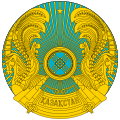Yurt: Difference between revisions
re-boldfaced title word (deleted bold on 12 July 2012) per Wikipedia:Manual of Style/Lead section |
No edit summary |
||
| Line 4: | Line 4: | ||
A '''yurt''' is a portable, [[Steam bending|bent]] wood-framed dwelling structure traditionally used by [[Turkic peoples|Turkic]] [[nomad]]s in the [[steppe]]s of [[Central Asia]]. The structure comprises a crown or compression wheel (tüýnük) usually [[steam bending|steam bent]], supported by roof ribs which are bent down at the end where they meet the [[latticework|lattice]] wall (again steam bent). The top of the wall is prevented from spreading by means of a tension band which opposes the force of the roof ribs. The structure is usually covered by layers of fabric and sheep's wool [[felt]] for insulation and weatherproofing. |
A '''yurt''' is a portable, [[Steam bending|bent]] wood-framed dwelling structure traditionally used by [[Turkic peoples|Turkic]] [[nomad]]s in the [[steppe]]s of [[Central Asia]]. The structure comprises a crown or compression wheel (tüýnük) usually [[steam bending|steam bent]], supported by roof ribs which are bent down at the end where they meet the [[latticework|lattice]] wall (again steam bent). The top of the wall is prevented from spreading by means of a tension band which opposes the force of the roof ribs. The structure is usually covered by layers of fabric and sheep's wool [[felt]] for insulation and weatherproofing. |
||
The similar [[Mongols|Mongolic]] nomadic structure the ''ger'' is often wrongly referred to by westerners as a yurt but differs in that the heavier roof wheel (toono) is supported on posts and the roof ribs are straight rather than bending down at the wall junction. The wall lattice of a ger is constructed of straight pieces as opposed to the yurt's curved lattice .<ref> |
The similar [[Mongols|Mongolic]] nomadic structure the ''ger'' is often wrongly referred to by westerners as a yurt but differs in that the heavier roof wheel (toono) is supported on posts and the roof ribs are straight rather than bending down at the wall junction. The wall lattice of a ger is constructed of straight pieces as opposed to the yurt's curved lattice .<ref>http://www.yurtinfo.org/yurtstory.php</ref> |
||
==Etymology and synonyms== |
==Etymology and synonyms== |
||
Revision as of 06:09, 27 August 2012
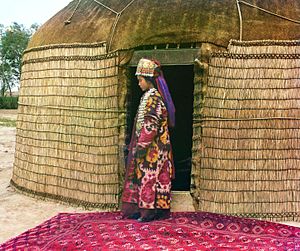
A yurt is a portable, bent wood-framed dwelling structure traditionally used by Turkic nomads in the steppes of Central Asia. The structure comprises a crown or compression wheel (tüýnük) usually steam bent, supported by roof ribs which are bent down at the end where they meet the lattice wall (again steam bent). The top of the wall is prevented from spreading by means of a tension band which opposes the force of the roof ribs. The structure is usually covered by layers of fabric and sheep's wool felt for insulation and weatherproofing.
The similar Mongolic nomadic structure the ger is often wrongly referred to by westerners as a yurt but differs in that the heavier roof wheel (toono) is supported on posts and the roof ribs are straight rather than bending down at the wall junction. The wall lattice of a ger is constructed of straight pieces as opposed to the yurt's curved lattice .[1]
Etymology and synonyms
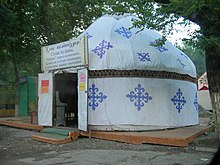
- Yurt - originally from a Turkic word referring to the imprint left in the ground by a moved yurt, and by extension, sometimes a person's homeland, kinsmen, or feudal appanage. The term came to be used in reference to the physical tent-like dwellings only in other languages. In modern Turkish the word "urt" is used as the synonym of homeland or a dormitory. In Russian the structure is called "yurta" (юрта), whence the word came into English.
- Jurta is what Hungarians whose origins are in Central Asia use for Yurt.
- киіз үй (transliterated: kïiz üy) - the Kazakh word, and means "felt house".
- боз үй (transliterated: boz üy) - the Kyrgyz term is meaning "grey house", because of the color of the felt.
- ak öý and gara öý - In Turkmen the term is both literally "white house" and "black house", depending on its luxury and elegance.
- гэр (transliterated: ger) - in Mongolian simply means "home".
- "Kherga"/"Jirga" - Afghans call them .
- "Kheymah" (خیمه) is the word for a yurt or a tent like dwelling in Pakistan, from the Urdu (and Persian) :خیمه In Persian yurt is called xeyme (خیمه), in Tajik the names are yurt, xona-i siyoh, xayma (юрт, хонаи сиёҳ, хайма).
History
Yurts have been in use at least since the 13th century, and there are indications that the design is much older.[2]
Construction
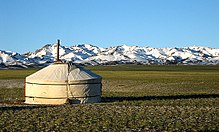
Traditional yurts consist of an expanding wooden circular frame carrying a felt cover. The felt is made from the wool of the flocks of sheep that accompany the pastoralists. The timber to make the external structure is not to be found on the treeless steppes, and must be obtained by trade in the valleys below.
The frame consists of one or more expanding lattice wall-sections, a door-frame, bent roof poles and a crown. The Mongolian Ger has one or more columns to support the crown and straight roof poles. The (self-supporting) wood frame is covered with pieces of felt. Depending on availability, the felt is additionally covered with canvas and/or sun-covers. The frame is held together with one or more ropes or ribbons. The structure is kept under compression by the weight of the covers, sometimes supplemented by a heavy weight hung from the center of the roof. They vary with different sizes, and relative weight.
A yurt is designed to be dismantled and the parts carried compactly on camels or yaks to be rebuilt on another site. Complete construction takes around 2 hours.
-
Mongolian Ger: starting with walls and door
-
Mongolian Ger: starting to place roof poles
-
Mongolian Ger: with roof poles in place
-
Mongolian Ger: placing the thin inner cover on the roof
-
Mongolian Ger: adding felt cover
-
Mongolian Ger: adding the outer cover
Decoration and Symbolism
The traditional decoration within a yurt is primarily pattern based. These patterns are generally not according to taste, but are derived from sacred ornaments with certain symbolism. Symbols representing strength are among the most common, including the khas (swastika) and four powerful beasts (lion, tiger, garuda and dragon), as well as stylized representations of the five elements (fire, water, earth, metal, and wood), considered to be the fundamental, unchanging elements of the cosmos. Such patterns are commonly used in the home with the belief that they will bring strength and offer protection.
Repeating geometric patterns are also widely used. The most widespread geometric pattern is the continuous hammer or walking pattern (alkhan khee). Commonly used as a border decoration it represents unending strength and constant movement. Another common pattern is the ulzii which as a symbol of long life and happiness. The khamar ugalz (nose pattern) and ever ugalz (horn pattern) are derived from the shape of the animal's nose and horns, and are the oldest traditional patterns. All patterns can be found among not only the yurts themselves, but also on embroidery, furniture, books, clothing, doors, and other objects.[3]
In Central Asia
-
shangyrak
-
Kazakh coat of arms
-
Kyrgyz flag
The wooden crown of the yurt (Mongolian: тооно, [tɔːn]; Kazakh: шаңырақ [ʃɑɴərɑ́q]; Kyrgyz: түндүк [tyndýk]; Turkmen: tüýnük) is itself emblematic in many Central Asian cultures. In old Kazakh communities, the yurt itself would often be repaired and rebuilt, but the shangrak would remain intact, passed from father to son upon the father's death. A family's length of heritage could be measured by the accumulation of stains on the shangrak from decades of smoke passing through it. A stylized version of the crown is in the center of the coat of arms of Kazakhstan, and forms the main image on the flag of Kyrgyzstan.
Today the yurt is seen as a nationalistic symbol among many Central Asian groups, and as such, yurts may be used as cafés (especially those specialising in traditional food), museums (especially relating to national culture), and souvenir shops.
Buddhist symbolism in the Mongolian Gers

The design of the Mongolian Ger developed from its ancient simple forms to actively integrate with Buddhist culture. The crown—toono adopted the shape of Dharmachakra. The earlier style of toono, nowadays more readily found in Central Asian yurts, is called in Mongolia "sarkhinag toono" while the toono representing Buddhist dharmachakra is called "khorlo" (Tibetan འཀོར་ལོ།) toono. Also the shapes, colors and ornaments of the wooden elements—toono, pillars and poles of the Mongolian yurt are in accord with the artistic style found in Buddhist monasteries of Mongolia. Such yurts are called "uyangiin ger" -- literally meaning "home of lyrics" or "home of melodies".
Western yurts
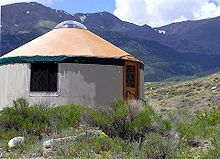
Enthusiasts in other countries have taken the visual idea of the yurt—a round, semi-permanent tent—and have adapted it to their cultural needs. Although those structures may be copied to some extent from the originals found in Central Asia, they often have some different features in their design that adapt them to different climate and use.
In the United States and Canada, yurts are made using hi-tech materials. They are highly engineered and built for extreme weather conditions. In addition, erecting one can take days and they are not intended to be moved often. These North American yurts are better named yurt derivations, as they are no longer round felt homes that are easy to mount, dismount and transport. North American yurts and yurt derivations were pioneered by William Coperthwaite in the 1960s, after he was inspired to build them by a National Geographic article about Supreme Court Justice William O. Douglas's visit to Mongolia.[4]
In 1978, Oregon-based company Pacific Yurts (http://pacificyurts.com/) became the first to manufacture yurts using architectural fabrics and structural engineering, paving the way for yurts to become popular attractions at ski resorts and campgrounds. In 1993, Oregon became the first state to incorporate yurts into its Parks Department as year round camping facilities. Since then, at least 17 other US States have introduced yurt camping into their own parks departments.[5]
In Europe, a closer approximation to the Mongolian and Central Asian yurt is in production in several countries. These tents use local hardwood, and often are adapted for a wetter climate with steeper roof profiles and waterproof canvas. In essence they are yurts, but some lack the felt cover that is present in traditional yurt.
Different groups and individuals use yurts for a variety of purposes, from full-time housing to school rooms. In some provincial parks in Canada, and state parks in several US states, permanent yurts are available for camping.
See also
- Architecture of Mongolia
- Flag of Kyrgyzstan
- List of human habitation forms
- Tent
- Yaranga
- Yurt quarter
- Mausoleum of Theodoric
References
- ^ http://www.yurtinfo.org/yurtstory.php
- ^ A complete guide to making a Mongolian Ger, webpage, retrieved October 23, 2011
- ^ van der Haegan, Bernard. "Mongolian ger decoration". Boston Star Consulting. Retrieved 27 October 2011.
- ^ Article at Alternatives Magazine on North American Yurts, webpage, retrieved February 9, 2006
- ^ Article at Midwest Weekends on Yurt Camping, webpage, retrieved December 08, 2010
External links
- yurtshawaii.com - An online video of yurt
- yurtforum.com - An online discussion about building, maintaining, and living in yurts
- Yurt FAQ
- Kazakh Yurta
- yurtinfo.org - A comprehensive resource for yurts and related structures
- Timothy Allen, BBC Earth Time lapse movie of a Mongolian yurt being constructed
- Simply Differently.org: Yurt Notes & Calculator, yurt building resources, how-to manuals and online calculator
- How to build a yurt by Paul King (PDF & HTML Book)
- Yurt Building - Documents the complete process of building a yurt from raw materials in pictures and text
- Kazakh Yurt Set-Up by Rebecca Schultz, informative video exposé from Kazakh community in northwestern China.
- Timelapse of Yurt construction at Blackdown Yurts - Devon, England by Mike Lusmore
- Kazakh Yurt About Yurt structure, decorations, sustainabile construction, etc. from VisitKazakhstan.kz.








